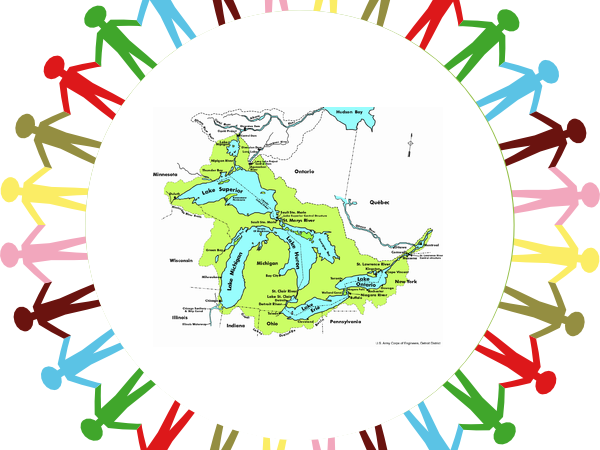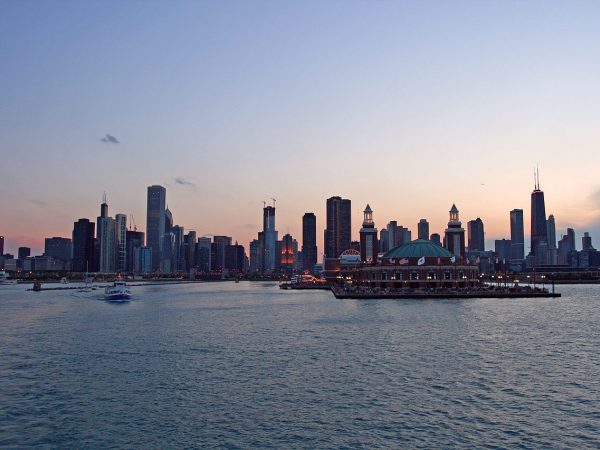
This article was republished here with permission from Great Lakes Echo.
By Kayla Nelsen, Great Lakes Echo
A California woman on “The Daily Show” recently swapped her sandals for snowshoes after moving to Duluth to escape her state’s wildfires.
The Comedy Central show featured Duluth as a climate haven, an ideal place to live to avoid wildfires, droughts, hurricanes and extreme flooding.
Minnesota is one of the states least vulnerable to the ravages of climate change, ranking in the 14th percentile for social and environmental vulnerability, according to the Environmental Defense Fund. Wisconsin falls within the same lower vulnerability category. New York, Michigan and Illinois follow with average vulnerability. Ohio, Pennsylvania and Indiana are the most vulnerable of the Great Lakes states.

Texas A&M and the Environmental Defense Fund developed an interactive national map in 2023 to display the climate change vulnerability of census tracts. It shows that southern states are more vulnerable to climate change impacts. Image: The U.S. Climate Vulnerability Index, Mapbox/OpenStreetMap.
The Great Lakes region has a lower risk of extreme weather compared to other parts of the country. Southern and western states are most vulnerable. They are the most likely to continue to experience sea level rise, drought and other social and environmental stressors, in the Environmental Defense Fund model.
Climate change risk may cause people to flee cities like Miami, Houston, Los Angeles and New Orleans, said Derek Van Berkel, an assistant professor at the University of Michigan School for Environmental Sustainability. Whether that’s a good decision depends on if other states are ready to receive them.
“Places like Duluth definitely could be a good place to live, but we’re going to have to plan now,” Van Berkel said. “In areas where we have quite aging infrastructure, that can be a big challenge. The notion of a climate haven is a little bit aspirational.”
The cities most prepared for climate change do not necessarily have a checklist of characteristics, Van Berkel said. Climate change planning looks different in different cities.
“We’re finding that cities are becoming more aware of the climate crisis,” Van Berkel said. “They’re having those conversations and that’s what makes them the most prepared because they’re thinking about things long term.”
Van Berkel has mapped the social and environmental risk of different counties across the Great Lakes states. His research team uses it as a basis for climate change planning conversations with city officials.
“The map gives a snapshot of the social and environmental challenges that Great Lakes cities have,” Van Berkel said. “It’s about evaluating exposure.”
The team plans to work within Duluth, Grand Rapids and Buffalo to implement urban planning strategies and will include community members in a collaborative process, Van Berkel said.
“It’s important for us to have local knowledge and understanding of the challenges of neighborhoods,” Van Berkel said. “It’s important we give people an equal voice in making decisions.”
First Street, a New York City-based nonprofit research organization, also brings climate change risk data into the hands of citizens. Users of its web-based tool can see a summary of a location’s climate change risks like flooding, wildfires, wind, heat and air quality.
“When we first started about seven years ago, there really was no way to get access to climate information for your city,” said Jeremy Porter, the group’s head of climate implications. “The role that we play is making this data available so that the public can make informed decisions.”
Homeowners in high-risk climate areas who are unprotected by flood insurance are forced to pay for damage out-of-pocket, Porter said. The most vulnerable homeowners are those within smaller communities that lack the resources to adapt to climate change.
Homeowners and governments bear the costs of climate change, Porter said.
Van Berkel and his team are considering how Great Lakes cities could adapt to climate change before social and environmental stressors reach those of the most vulnerable U.S. cities.
“To realize the climate haven aspiration, we’ll have to have urban planning conversations early and often,” Van Berkel said.
The team is exploring how more dense neighborhoods may help balance maintaining a tax base and maintaining infrastructure. That means more community living and less single-family housing. The idea is to reduce the need for new infrastructure – sewers, water mains, streets – without reducing populations.
“We have to prepare our cities and make them attractive, welcoming and liveable for years to come,” Van Berkel said.
A Great Lakes regional population surge from climate change migration is not inevitable, Van Berkel said. Other population dynamics like the aging out of the Baby Boomer generation can offset the potential influx of climate change migrants.
“There’s really two sides to the story,” Porter said. “One of them is that some areas in the Midwest are less prone to climate disasters. But they’re probably not going to grow just because of that. There has to be some restructuring of our economic centers also.”
Through preemptive urban planning scenarios, Duluth and other Great Lakes cities are defining what it means to be a climate haven.
“We need these extreme scenarios to start to grapple with new ways of building our cities to imagine what they could look like,” Van Berkel said.
Catch more news at Great Lakes Now:
Indiana conservation groups defend state’s wetlands that lost protection
Featured image: University of Michigan assistant professor Derek Van Berkel mapped social and environmental risk within the Great Lakes states in 2022. It is based on data from The Federal Emergency Management Agency and from The Center for Disease Control and Prevention. Darker shades of blue indicate high environmental risk, while darker shades of green indicate a high social vulnerability index ranking. Shades of gray indicate low vulnerability for both. Image: Derek Van Berkel.




